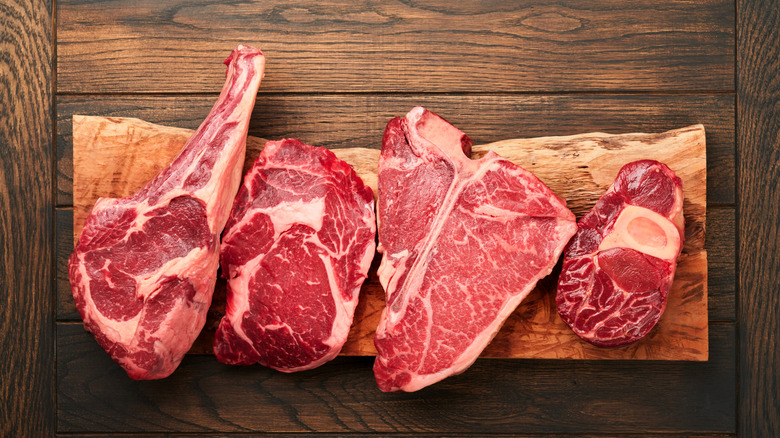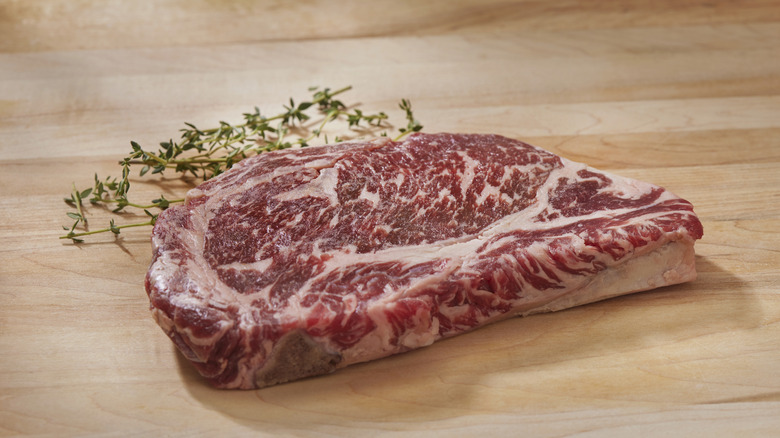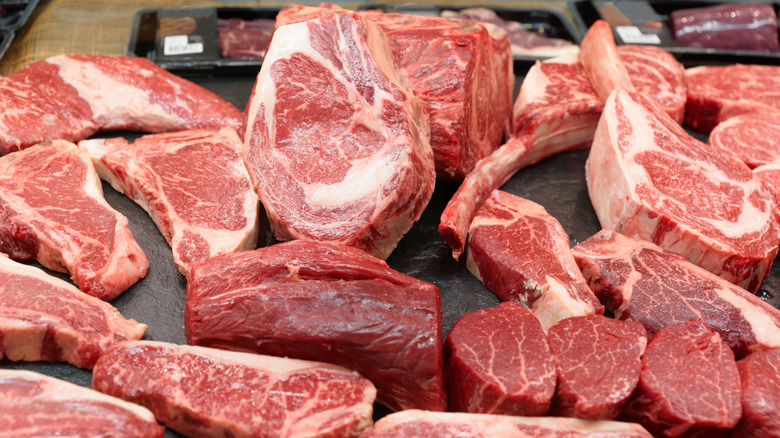Prime Vs Choice Beef: The Quality Difference, Explained
If you aren't an expert, meat labels can be intimidating. You might find yourself wading through declarations of "grass-fed" or "organic" or "antibiotic free" — wondering how all these designations will actually affect the taste and the price. And while some food labels do come down to nothing more than marketing (think "natural" or "reduced sugar"), many of the labels you'll find on meat are certifications regulated by the U.S. Department of Agriculture (USDA). So if beef is called organic or naturally raised, certain standards are being met. The same goes for the grade. When you make a decision between Choice and Prime beef, you're actually choosing between two different quality cuts.
USDA grading started in the 1920s to establish quality standards; grading examines attributes like tenderness and marbling, which is the flecks of fat within the muscle. That determination is made by a USDA Agricultural Marketing Service grader who looks at a single section of the animal — falling at the very end of the ribeye — to decide whether the whole thing should be labeled Prime, Choice, Select, or a lower grade. There are subsets of each of these grades, which usually aren't included in grocery store labels, so there can be dissimilarity even within the grade. Even so, this grade label will tell you a lot about the meat's texture and taste and what cut of meat you should buy. Prime beef sits at the top of the scale, but Choice beef is the next best thing.
Prime beef is the top of the line
As the quality standards are so high, only around 3% of beef in the U.S. earns the Prime grade. Prime beef has two separate standards for younger and older cattle as determined by several physical markers (in case you're interested, it has to do with fused vertebrae and bone density), but the primary determinant of grade is the presence of marbling. Graders look for marbling in the ribeye muscle and have to decide if this intramuscular fat is at least "slightly abundant" and if the muscle is "moderately firm" for the younger group, and "firm" for the older group.
As you might imagine, this is somewhat subjective language, and as mentioned, there are subcategories within the Prime grade (for example, abundant marbling will lead to a "high Prime" designation) — but even the presence of marbling that is at least slightly abundant, usually about 8% to 13% fat, does have a tangible effect on the meat. Prime beef will be more flavorful and tender than its lower grade counterparts, and its texture holds up well to grilling or roasting. Keep in mind though: Prime beef will also be a more expensive cut of steak because of its quality.
Choice beef is, well, still choice
Although it's a step below on the grade scale, Choice beef is often still high quality. Representing a large percentage of meat on the market, this grade also divides its standards into two age groups based on those same physical markers. For the younger group, marbling must be a "minimum small amount" and the muscle can be slightly soft. For the older group, a "minimum modest amount" of marbling is necessary, with slightly firm muscle. There is a significant range of quality within the Choice grade, and the best Choice-grade beef is only slightly below Prime. If you want to make sure that you're getting the higher end, you might be able to find "High Choice" beef, marked by a private label like CAB Choice that indicates the beef is the best quality of the Choice grade. It's a separate designation from USDA Choice and costs a bit more, but labels like CAB Choice guarantee you're getting the highest quality in this grade.
These higher quality Choice cuts will still work well with dry-heat methods, like grilling, without losing their texture. However, if you find yourself with beef on the lower end of Choice, braising or roasting might be the better option to help retain the cut's tenderness. Regardless of your chosen cooking method, you'll now be well equipped to choose the perfect cut at the store.



